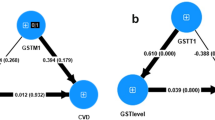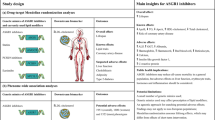Abstract
The genetic alteration in the antioxidant gene Glutathione-S-Transferases Pi 1 (GSTP1) namely GSTP1*IIe105Val (rs1695) and GSTP1*Ala114Val (rs1138272) changes the individual susceptibility to cardiovascular disease (CVD) and type 2 diabetes mellitus (T2DM) by altering the substrate binding and catalytic activity. This study aims to investigate the association of GSTP1 rs1695 and rs1138272 polymorphism with CVD development in T2DM patients. Genoty** was performed with 400 study participants—group I: control; group II: T2DM; group III: CVD; and group IV: T2DM/CVD [n = 100 each] by PCR–RFLP. The rs1695 and rs1138272 polymorphism were docked against NPACT and NUBBE database and virtually screened using glide. The study reported that rs1695 polymorphism was associated with T2DM risk under dominant and allelic genetic models [OR = 1.97(1.08–3.59) p = 0.02 and OR = 1.79(1.20–2.66) p = 0.003, respectively]. The val/val genotype, dominant, recessive model, and T allelic genetic model were associated with increased CVD risk [OR = 4.15(1.97–8.73) p = < 0.01; OR = 3.16(1.65–6.04) p = < 0.01; OR = 3.47(1.91–6.31) p = < 0.01; and OR = 2.94(1.95–4.43) p = < 0.01, respectively]. In contrast, rs1695 polymorphism was not associated with CVD development among patients with T2DM. In rs1138272, the wild genotype was only detected and neither heterozygous nor val/val genotype was observed. The docking analysis revealed that the Ile105Val mutation plays a significant role in altering the GSTP1 capacity compared to the Ala115Val mutation. This suggests that the Ile105Val mutation has a greater impact on the protein's structure, function, or susceptibility to diseases compared to the Ala115Val mutation. In summary, genetic alteration in GSTP1 rs1695 potentially contributes to an increased risk of T2DM and CVD.



Similar content being viewed by others
Data Availability
The datasets generated during and/or analysed during the current study are available from the corresponding author on reasonable request.
References
Amer MA, Ghattas MH, Abo-ElMatty DM, Abou-El-Ela SH (2012) Evaluation of glutathione S-transferase P1 genetic variants affecting type-2 diabetes susceptibility and glycemic control. Arch Med Sci 8(4):631
Azarova I, Bushueva O, Konoplya A, Polonikov A (2018) Glutathione S-transferase genes and the risk of type 2 diabetes mellitus: Role of sexual dimorphism, gene-gene and gene-smoking interactions in disease susceptibility. J Diabetes 10(5):398
Bandeira SDM, Da Fonseca LJS, Guedes GDS, Rabelo LA, Goulart MOF, Vasconcelos SML (2013) Oxidative stress as an underlying contributor in the development of chronic complications in diabetes mellitus. Int J Mol Sci 14(2):3265–3284. https://doi.org/10.3390/ijms14023265
Bhat MA, Gandhi G (2017) Glutathione S-transferase P1 gene polymorphisms and susceptibility to coronary artery disease in a subgroup of north Indian population. J Genet 96(6):927–932. https://doi.org/10.1007/s12041-017-0863-y
Bhatti JS, Vijayvergiya R, Singh B, Bhatti GK (2018) Genetic susceptibility of glutathione S-transferase genes (GSTM1/T1 and P1) to coronary artery disease in Asian Indians. Ann Hum Genet 82(6):448
Cui J, Li G, Yin J, Li L, Tan Y, Wei H, Liu B, Deng L, Tang J, Chen Y, Yi L (2020) GSTP1 and cancer: expression, methylation, polymorphisms and signaling (Review). Int J Oncol 56(4):867
Ding F, Li JP, Zhang Y, Qi GH, Song ZC, Yu YH (2019) Comprehensive analysis of the association between the rs1138272 polymorphism of the GSTP1 gene and cancer susceptibility. Front Physiol 9:1897. https://doi.org/10.3389/fphys.2018.01897
Geng X, Zha L, **ong Y, Xu F, Xu B, Wang F, Wang X, Yang K, Tao W, Li Y, Zhou T (2020). Influence of GSTT1 and GSTP1 polymorphisms on type 2 diabetes mellitus and diabetic retinopathy risk in the Chinese population: a case control study. Research Square.
Grubisa I, Otaševic P, Despotovic N, Dedic V, Milašin J, Vucinic N (2013) Genetic polymorphism of Glutathione S-Transferase p1 (GSTP1) ile105val and susceptibility to atherogenesis in patients with type 2 diabetes mellitus. Genetika 45(1):227–236
Jayaraj JM, Kuriakose BB, Alhazmi AH, Muthusamy K (2021) Structural and functional insights on vitamin D receptor and CYP24A1 deleterious single nucleotide polymorphisms: a computational and pharmacogenomics perpetual approach. Cell Biochem Funct 39(7):874–885. https://doi.org/10.1002/cbf.3658
Kassogue Y, Diakite B, Kassogue O, Konate I, Tamboura K, Diarra Z, Dehbi H, Nadifi S, Traore CB, Dao S, Doumbia S, Dolo G (2020) Genetic polymorphism of drug metabolism enzymes (GSTM1, GSTT1 and GSTP1) in the healthy Malian population. Mol Biol Rep 47(1):393–400. https://doi.org/10.1007/s11033-019-05143-5
Lavender NA, Benford ML, VanCleaveTT BGN, Kittles RA, MooreJH HDW, Kidd LC (2009) Examination of polymorphic glutathione S-transferase (GST) genes, tobacco smoking and prostate cancer risk among Men of African Descent: a case-control study. BMC Cancer 9:397. https://doi.org/10.1186/1471-2407-9-397
Liu LS, Wang D, Tang R, Wang Q, Zheng L, Wei J, Li Y, He XF (2022) Individual and combined effects of the GSTM1, GSTT1, and GSTP1 polymorphisms on type 2 diabetes mellitus risk: a systematic review and meta-analysis. Front Genet 13:959291
Loganathan L, Muthusamy K, Jayaraj JM, Kajamaideen A, Balthasar JJ (2019) In silico insights on tankyrase protein: a potential target for colorectal cancer. J Biomol Struct Dyn 37(14):3637–3648. https://doi.org/10.1080/07391102.2018.1521748
Loganathan L, Natarajan K, Muthusamy K (2020) Computational study on cross-talking cancer signalling mechanism of ring finger protein 146, AXIN and Tankyrase protein complex. J Biomol Struct Dyn 38(17):5173–5185. https://doi.org/10.1080/07391102.2019.1696707
Ma J, Zhu SL, Liu Y, Huang XY, Su DK (2017) GSTP1 polymorphism predicts treatment outcome and toxicities for breast cancer. Oncotarget 8(42):72939–72949. https://doi.org/10.18632/oncotarget.18513
Ma CX, Ma XN, Guan CH, Li YD, Mauricio D, Fu SB (2022) Cardiovascular disease in type 2 diabetes mellitus: progress toward personalized management. Cardiovasc Diabetol 21(1):74. https://doi.org/10.1186/s12933-022-01516-6
Martín-Timón I, Sevillano-Collantes C, Segura-Galindo A, Del Cañizo-Gómez FJ (2014) Type 2 diabetes and cardiovascular disease: have all risk factors the same strength? World J Diabetes 5(4):444–470. https://doi.org/10.4239/wjd.v5.i4.444
Mir O, Alexandre J, Tran A, Durand JP, Pons G, Treluyer JM, Goldwasser F (2009) Relationship between GSTP1 Ile(105)Val polymorphism and docetaxel-induced peripheral neuropathy: clinical evidence of a role of oxidative stress in taxane toxicity. Ann Oncol 20(4):736
Nagamani S, Kesavan C, Muthusamy KE (2012) Pharmacophore map** and docking studies on Vitamin D receptor (VDR). Bioinformation 8(15):705–710. https://doi.org/10.6026/97320630008705
Narasimman V, Ramachandran S (2023) In silico analysis of low molecular weight sulfated chitosan from Sepia brevimana as potential inhibitors of white spot syndrome envelope proteins. Biomass Conv Bioref. https://doi.org/10.1007/s13399-023-03844-3
Okat Z (2018) Clinical importance of glutathione-s-transferase enzyme polymorphisms in cancer. Int Phys Med Rehab J 3(6):491–493. https://doi.org/10.15406/ipmrj.2018.03.00153
Orlewska K, Klusek J, Głuszek S, Klusek J, Witczak B, Wawszczak M, Madej Ł, Marzec MT, Orlewska E (2023) Glutathione S-transferase P1 genetic variant’s influence on the HbA1c level in Type two diabetic patients. Int J Environ Res Public Health 20(2):1520
Pandi S, Kulanthaivel L, Subbaraj GK, Rajaram S, Subramanian S (2022) Screening of potential breast cancer inhibitors through molecular docking and molecular dynamics simulation. BioMed Res Int 2022:3338549. https://doi.org/10.1155/2022/3338549
Poochi SP, Easwaran M, Balasubramanian B, Anbuselvam M, Meyyazhagan A, Park S, Bhotla HK, Anbuselvam J, Arumugam VA, Keshavarao S, Kanniyappan GV (2020) Employing bioactive compounds derived from Ipomoea obscura (L.) to evaluate potential inhibitor for SARS-CoV-2 main protease and ACE2 protein. Food Front 1(2):168–179. https://doi.org/10.1002/fft2.29
Ramprasath T, Murugan PS, Prabakaran AD, Gomathi P, Rathinavel A, Selvam GS (2011) Potential risk modifications of GSTT1, GSTM1 and GSTP1 (glutathione-S-transferases) variants and their association to CAD in patients with type-2 diabetes. Biochem Biophys Res Commun 407(1):49–53. https://doi.org/10.1016/j.bbrc.2011.02.097
Santhi Priya S, Kumar Ebenezar K (2023) Diabetes and cardiovascular disorder. Advances in diabetes research and management. Springer, Berlin, pp 41–61
Sastry MG, Adzhigirey M, Day T, Annabhimoju R, Sherman W (2013) Protein and ligand preparation: parameters, protocols, and influence on virtual screening enrichments. J Comput-Aided Mol Des 27(3):221–234. https://doi.org/10.1007/s10822-013-9644-8
Singh N, Sinha N, Kumar S, Pandey CM, Agrawal S (2011) Glutathione S-transferase gene polymorphism as a susceptibility factor for acute myocardial infarction and smoking in the North Indian population. Cardiology 118(1):16
Sobha SP, Kesavarao KE (2022) Contribution of glutathione-S-transferases polymorphism and risk of coronary artery diseases: a meta-analysis. Curr Aging Sci 15(3):282–292. https://doi.org/10.2174/1874609815666220304193925
Sobha SP, Kesavarao KE (2023) Progonostic effect of GSTM1/GSTT1 polymorphism in determining cardiovascular diseases risk among type 2 diabetes patients in South Indian population. Mol Bio Rep 50(8):6415–6423
Stoian A, Bănescu C, Bălaşa RI, Moţăţăianu A, Stoian M, Moldovan VG, Voidăzan S, Dobreanu M (2015) Influence of GSTM1, GSTT1, and GSTP1 polymorphisms on type 2 diabetes mellitus and diabetic sensorimotor peripheral neuropathy risk. Dis Markers 2015:638693. https://doi.org/10.1155/2015/638693
Zaki MA, Moghazy TF, El Deeb MMK, Mohamed AH, Mohamed NAA (2015) Glutathione S-transferase M1, T1 and P1 gene polymorphisms and the risk of develo** type 2 diabetes mellitus in Egyptian diabetic patients with and without diabetic vascular complications. Alexandria J Med 51:73–82
Acknowledgements
The authors acknowledge Chettinad Academy of Research and Education, Kelambakkam, India, for providing the infrastructure facilities to carry out the work and Dr. Govindaraju Soundararajan for his assistance and support in data analysis with statistics. We would also like to acknowledge Indian Council of Medical Research (ICMR), New Delhi, India for the funding in the form of Senior Research Fellowship (SRF).
Funding
The authors declare that no funds or grants were received during the preparation of this manuscript.
Author information
Authors and Affiliations
Contributions
All authors contributed to the study conception and design. Methodology, manuscript writing—original draft, investigation, and data curation were performed by Santhi Priya S; Bioinformatics investigation, bioinformatics writing—manuscript were performed by Jeyanthi Sankar and Karthikeyan Muthusamy; Writing review and editing were performed by Kumar Ebenezar K and Karthikeyan Muthusamy. All authors read and approved the final manuscript.
Corresponding author
Ethics declarations
Competing Interests
The authors have no relevant financial or non-financial interests to disclose.
Ethical Approval
This study was performed in line with the principles of the Declaration of Helsinki. Approval was granted by the Institutional Human Ethics Committee (IHEC), Chettinad Academy of Research and Education, Chettinad Hospital and Research Institute, Kelambakkam-603103, Chengalpattu Dt., TN, India (Date: 05/12/2019; IHEC No: 611/IHEC/11-19).
Consent to Participate
Informed consent was obtained from all individual participants included in the study.
Additional information
Publisher's Note
Springer Nature remains neutral with regard to jurisdictional claims in published maps and institutional affiliations.
Rights and permissions
Springer Nature or its licensor (e.g. a society or other partner) holds exclusive rights to this article under a publishing agreement with the author(s) or other rightsholder(s); author self-archiving of the accepted manuscript version of this article is solely governed by the terms of such publishing agreement and applicable law.
About this article
Cite this article
Sobha, S.P., Sankar, J., Muthusamy, K. et al. Risk of Cardiovascular Complications Among Type 2 Diabetes Mellitus Patients with GSTP1 Genetic Polymorphism: A Nested Case–Control Study and Docking Studies. Biochem Genet (2024). https://doi.org/10.1007/s10528-024-10823-4
Received:
Accepted:
Published:
DOI: https://doi.org/10.1007/s10528-024-10823-4




